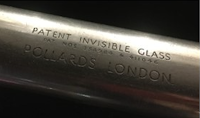Heading down Tottenham Court Road on a bus in early March this year, I noticed that Habitat had moved out. Oh dear. I got off the bus to take a few snaps. The exterior signage had been removed and the interior was being stripped. The lovely curved display windows that run around the shop on both sides were covered in dust.
The windows around this part of the building are double co-joined curves – an expensive innovation, but this design allows the products to be seen clearly rather than be hindered by reflections from the street. The glass would have been installed in the late 1930s by Pollards, the go-to shop-fitting company of that era who had 'imported' this curved glass idea from the US.I went back in April and took some more photos. With all the furniture removed this gave clear views across the store space of the windows. Really good infitity shots are to be had from the exterior where mirrored end panels along the top sections repeat the curves.
There are only a handful of places in London where Pollards' unusual horizontal curved glass can be found these days and each install is unique...
Fox umbrellas, at London Wall, Moorgate, was established in nearby Fore Street in 1868. As I understand, this is the first site where Pollards' curved glass was installed. It's really hard to photograph, especially when the place, which is today a cafe bar, is closed during lockdown or open with people sat at tables outside on the pavement.
The double curves at the Fox shop here are shallower than at the other sites. I haven't a clue what those blobby bits of art in the window were supposed to be! At the extreme right end of the hand rail there is an imprint showing Pollards' non reflecting window patent numbers.
The shop also retains many of the early C20th interior wood fittings. Pre-this Jazz Age refit, the display windows would have looked something like James Smith & Sons, New Oxford Street.
And then, of course, we have what is possibly the best-known example of these windows at Joseph Emberton's marvellous building for Alexander Simpson, a stone's throw from Piccadilly Circus. It opened in 1936 selling Simpson's range of men's clothing and is today home to Waterstone's bookshop. Here we a have two sets of single deep curves, again with the mirrored ends. During the Christmas 2018 period part of the windows were damaged and suffered huge cracks, as shown below protected by thick adhesive plasitc sheets. This being a Grade I listed building, the glass has since been replaced. Phew.

More about Pollards in italics at the bottom.
The fourth/last London example, unless someone can tell me where to find others, is on the old gas showroom on Crouch End Broadway, today home to Barclays Bank, where double shallow curves meet and point towards us along both sides of the building. No Pollards markers to be found but there's some really nice Art Deco geometric metalwork at low level.
Edward Pollard, shopfitter, company founded 1895. Listed at 134E+F Kingsland Rd, E2, as E.Pollard. 1906 moved to 29 Clerkenwell Rd. In 1913 E. Pollard & Co. designed and fitted Carreras Piccadilly shop. c1919 built a factory in Highbury. 1920s showrooms at 299 Oxford St (branches in Bristol, Manchester, Glasgow, Dublin). By 1923 E. Pollard & Co.Ltd also have second Clerkenwell premises at 158-187 St John St (Hammond+Champness lifts building, rebuilt 1925-27). 1967 Pollard Group relocated to Basingstoke.
UPDATE: see the comments for reference of similar curved glass at HMV, 363 Oxford Street, which I have written about separately here.







